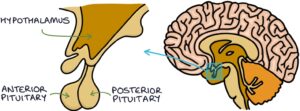Hormones are messenger chemicals that travel in the blood between organs and tissues, regulating many processes. A hormone axis is a system that controls the amount of a hormone in the system. Too much or too little of a hormone can have significant consequences.
Most hormones in the body are controlled by two structures in the middle part of the brain: the hypothalamus and the pituitary gland. The hypothalamus sits above the pituitary gland.

The hypothalamus releases hormones that stimulate the pituitary gland, and the pituitary gland releases hormones in response. This way, the hypothalamus controls the pituitary.
Hypothalamus
The hypothalamus releases:
- Thyrotropin-releasing hormone (TRH) – stimulates thyroid-stimulating hormone secretion by the pituitary
- Corticotropin-releasing hormone (CRH) – stimulates adrenocorticotropic hormone secretion by the pituitary
- Gonadotropin-releasing hormone (GnRH) – stimulates luteinising hormone (LH) and follicle-stimulating hormone (FSH) secretion by the pituitary
- Growth hormone-releasing hormone (GHRH) – stimulates growth hormone (FSH) secretion by the pituitary
- Somatostatin (growth hormone-inhibiting hormone, GHIH) – inhibits growth hormone release by the pituitary
- Dopamine (prolactin-inhibiting hormone, PIH) – inhibits prolactin release by the pituitary
Pituitary
The pituitary gland has an anterior and posterior part.
The anterior pituitary gland releases:
- Thyroid-stimulating hormone (TSH) – stimulates thyroid hormone secretion by the thyroid gland
- Adrenocorticotropic hormone (ACTH) – stimulates cortisol secretion by the adrenal glands
- Follicle-stimulating hormone (FSH) and luteinising hormone (LH) – control sex hormone secretion by the gonads (testicles in males or ovaries in females)
- Growth hormone (GH)
- Prolactin – stimulates breast milk production
- Melanocyte-stimulating hormone (MSH) – stimulates melanocytes to produce melanin, increasing skin pigmentation
The posterior pituitary releases:
- Oxytocin (produced in the hypothalamus and secreted by the pituitary) – stimulates uterine contractions during childbirth and milk ejection during breastfeeding, and plays a role in social bonding and pleasure
- Antidiuretic hormone (ADH) (produced in the hypothalamus and secreted by the pituitary) – stimulates water reabsorption from the urine in the collecting ducts of the kidneys
Last updated July 2024
Now, head over to members.zerotofinals.com and test your knowledge of this content. Testing yourself helps identify what you missed and strengthens your understanding and retention.

